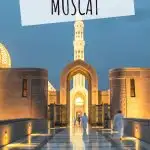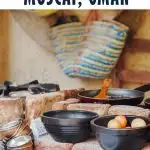Muscat is a sprawling city, with several interesting neighborhoods, each with their own character and Muscat highlights.
If you are planning a trip to Oman and are looking for things to do in Muscat, this extensive Muscat city guide is for you!
The best things to do in Muscat
Disclosure: Some links in this post are affiliate links. If you make a purchase through one of these links, we may earn a small commission (at no extra cost to you!). We're very grateful when you use our links to make a purchase:-).
This post has been created in collaboration with several other travel bloggers, who have shared their favorite Muscat sightseeing activity to create this post and inspire you to visit Muscat, Oman.
Muscat tourist map
All the activities in Muscat mentioned above can be found on the map below. I've also added the Muscat hotels in the different price ranges.
Click here for the interactive map
10 things to see and do in Muscat
- Visit the Sultan Qaboos Grand Mosque
- Enjoy traditional Omani food at Kargeen
- Go hiking in Muttrah
- Stroll along Muttrah Corniche
- Shop at Muttrah Souq
- Learn about Oman in the National Museum
- Go on an Eco-dolphin watching tour
- Visit Bait-Al-Baranda Museum
- Enjoy a show at the Royal Opera House
- Relax at Shatti Al Qurum Beach

Top 5 tours in and around Muscat
- Muscat city tour (half day): explore Muscat on a half-day tour of the traditional markets and city landmarks, such as the Sultan Qaboos Grand Mosque. Learn about the history and modern-day culture of the cosmopolitan city. Click here to book.
- Dolphin-watching tour: experience an amazing dolphin-watching tour off the coast of Muscat. Sail around Oman’s beautiful coastline and admire the crystal-clear waters while keeping your eyes peeled for pods of dolphins. Click here to book.
- Go snorkeling at the Dimaniyat Islands: enjoy a full day out on the water with this small-group snorkeling cruise to the Dimaniyat Islands. Look for fish, turtles, and other sea life in the pristine corals and bays. Click here to book.
- Take a day trip to Wadi Shab: discover Wadi Shab, a magical waterfall within a cave, and go for a swim in one of the pools. Marvel at the Bimmah Sinkhole on the way back. Click here to book.
- Visit Nizwa and Al Hamra: spend a day discovering Nizwa and experience a great hike in Al Hamra, one of Oman's most beautiful villages. Click here to book.
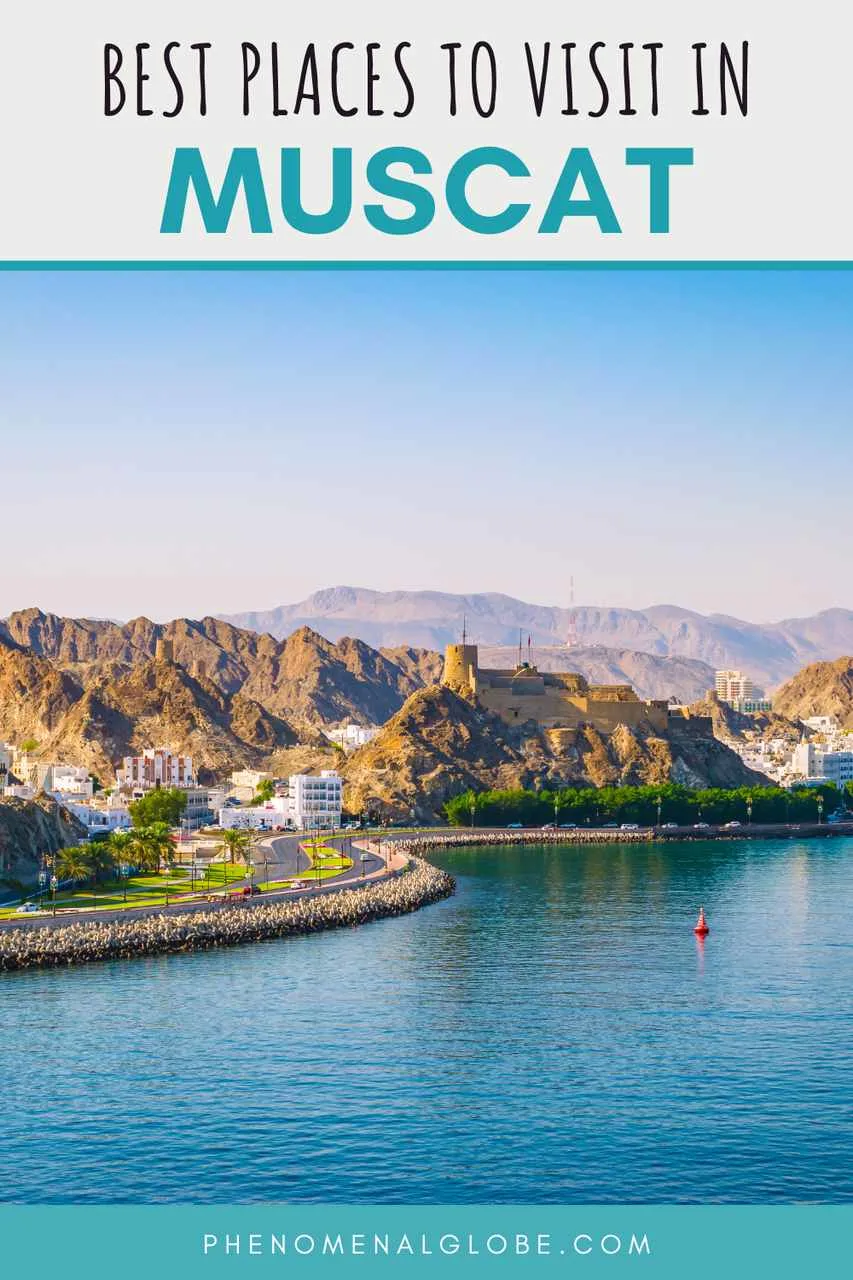
Things to know when planning a trip to Muscat
Muscat is the capital of Oman and is located in the north of this beautiful country, on the Gulf of Oman. With approximately 1.7 million residents it's the biggest city in Oman.
For anyone wondering ‘is Muscat worth visiting‘, I can say from personal experience: yes, absolutely!
The best time to visit Muscat is during the winter months (November-March). Winter does not mean cold in Oman, it means comfortable.
The average temperature is usually below 30°C, contrary to the unbearable heat of the summer months (April to September).
Yes, you need a visa for Oman, unless you are a resident of the U.A.E., Bahrain, Kuwait, Qatar, or Saudi Arabia.
Getting an Oman visa isn't difficult, you can easily apply for an E-visa online. There is even a video tutorial to walk you through the process.
Depending on the length of your visit, you will either need a 10-day tourist visa (5 OMR) or a 30-day tourist visa (20 OMR).
The currency of Oman is the Omani Rial (OMR). Coins have a denomination of 5, 10, 25, 50, 100 baisas, and 0.25 and 0.50 rials.
Banknote denomination is 100 and 200 baisas, and 0.50, one, five, 10, 20, and 50 rials.
Plan your trip to Oman like a pro with these tools:
✈️ Find the best flight deals on Kiwi.com.
? Get the best 4×4 rental deal for your road trip on Rentalcars.com.
? Stay connected with an Oman SIM card.
? Plan your journey with the Oman Lonely Planet.
?️ Find your dream accommodation on Booking.com or Agoda.
? Book the best tours via Get Your Guide or Viator.
?️ Travel safely and get reliable travel insurance from Safety Wing.
The best places to stay in Muscat
There are many excellent hotels in Muscat, from luxury resorts to very affordable accommodations for those traveling to Oman on a budget.
In the table below you can find my recommendations. More information about these hotels can be found further down in the post.
| Name | Stars | Rating | Price | Agoda | Booking |
|---|---|---|---|---|---|
| Mutrah Hotel | ☆☆ | 7.9 | US$40 | Click here | Click here |
| The Secure Inn Hotel | ☆☆☆ | 7.9 | US$49 | Click here | Click here |
| Levatio Hotel | ☆☆☆☆ | 8.3 | US$58 | Click here | Click here |
| Hilton Garden Inn Muscat Al Khuwair | ☆☆☆☆ | 8.5 | US$233 | Click here | Click here |
| Al Bustan Palace | ☆☆☆☆☆ | 8.9 | US$727 | Click here | Click here |
| W Muscat | ☆☆☆☆☆ | 8.9 | US$395 | Click here | Click here |
Note: in Oman, hotel rates vary considerably throughout the year. During high season, from November until the end of March, hotel prices are much higher than during the low (because scorching hot) season, which runs from April until October.
Therefore, the prices mentioned above are a rough indication of the price per night to help you compare the different options. Use ‘click here' to see the latest prices on Agoda and Booking and book ahead to get the best deal.

How to get around Muscat
Muscat is a very spread-out city, due to the lack of high-rise buildings. Therefore distances between places to see in Muscat are large and it takes some time to get from one side to the other.
There are several ways to get around in Muscat:
- Public transport: there are buses in Muscat and they are very cheap. You can find timetables and routes here. Note that not all Muscat sights are close to a bus station, so some walking is definitely needed when getting around Muscat by bus.
- Taxi or microbus: there are many taxis and micro-buses in Muscat. Except for official Muscat airport taxis, taxis in Muscat don't have meters so bargaining is required, even then they are usually quite expensive.
- Rent a car: despite the fact that traffic is rather heavy in Muscat (unlike the rest of Oman, which is why it's a great place for a road trip), a rental car is the easiest way to get around the city. Roads and signage are generally good and parking is available at most sites and hotels.

What to wear in Muscat
Islam is the state religion in Oman and it's very important to dress appropriately, also as a tourist.
Omani men generally wear a dishdasha (an ankle-length collarless gown) and many women wear abayas (long black dresses).
While you don't have to dress as the Omanis do, please dress conservatively. Wear loose clothes, and long sleeves and avoid shorts.
Especially when visiting religious places, be sure to wear appropriate clothes and behave respectfully!
What to do in Muscat: 10 great attractions in Muscat
Visit the Sultan Qaboos Grand Mosque
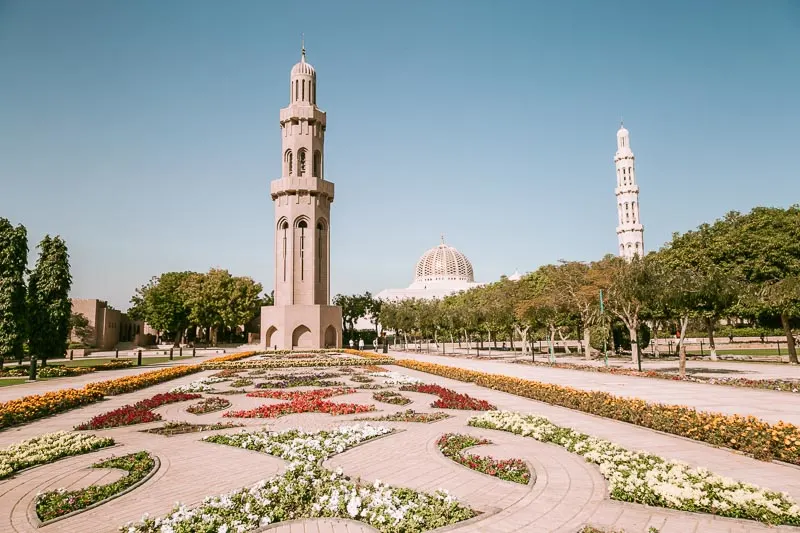
Jeff from Our Passion For Travel: a visit to Muscat is not complete without checking out the impressive Sultan Qaboos Grand Mosque. Arguably the most impressive mosque in all of Oman, it was completed in 2001.
Its five minarets define the pillars of Islam, with the tallest reaching some 91 meters high.
Outside of the mosque, there are several pristine and meticulously maintained courtyards and walkways, each with its own impressive patterns.
Inside the mosque, you’ll find some interesting and beautiful pieces. At the time of opening, the mosque was home to the world’s largest chandelier.
Besides 600,000 Swarovski crystals covering its 14 meters of height, the chandelier is also covered with 24-carat gold plating. This chandelier is heavyweight by any standard, weighing in at 8.5 tonnes!
The big theme doesn’t end there. You’ll find what was once the world’s largest carpet in the Prayer Hall, which can hold 6500 worshipers. It’s 60 by 70 meters in size and took over four years to complete.
The mosque is beautiful inside and out, but so too are the people. If you seek out an Imam as we did, they’ll sit you down over some Omani coffee and dates and provide an overview of Islam, unravel any myths, and answer any questions you might have.
This unique experience comes at no cost to visitors and welcomes those from all faiths.
Enjoy traditional Omani food at Kargeen

Emily from Wander-Lush: if you are looking to sample traditional Omani cuisine at an Omani restaurant, Muscat has many excellent options.
Even if you’re traveling in Oman on a budget, I highly recommend splashing out for brunch at Kargeen, where you can sample some of the best national fares in the capital.
The name Kargeen translates to ‘little wooden cottage’. The locally-owned restaurant, which has been a Muscat mainstay since 1997, occupies a beautiful indoor-outdoor space with traditional timber and concrete architecture.
The smell of frankincense greets you as you enter the dining room, which is decorated in traditional style with ornate lighting and antique carpets.
In the cafe’s leafy courtyard, there are different kitchen ‘stations’ set up where you can watch chefs preparing khubz ragag, traditional Omani bread. And that’s all before you sit down to eat!
Kargeen specializes in Omani and Arabic cuisine, served alongside an extensive range of western dishes. If it’s traditional food you’re interested in, don’t look past the Omani Breakfast.
It consists of bubbly rukhal bread served with zaatar, cheese, and honey, Omani-style eggs cooked up with tomatoes, more eggs, this time sweetened with date syrup, chickpea masala, semya, and lots of Omani coffee or tea on the side.
Dishes are served in delightful little pots and enjoyed sharing style.
Kargeen is located on Al Bashair Street in Muscat’s diplomatic area, about a 15-minute drive from Sultan Qaboos Grand Mosque.
The café is open daily for breakfast, lunch, and dinner from 7 am – except on Fridays when it opens at 12 midday.
A breakfast set costs 6.600 OMR (roughly 17 USD) per person at the time of writing, but for the ambiance and the taste, I think it’s absolutely worth it.
Hiking in Muttrah
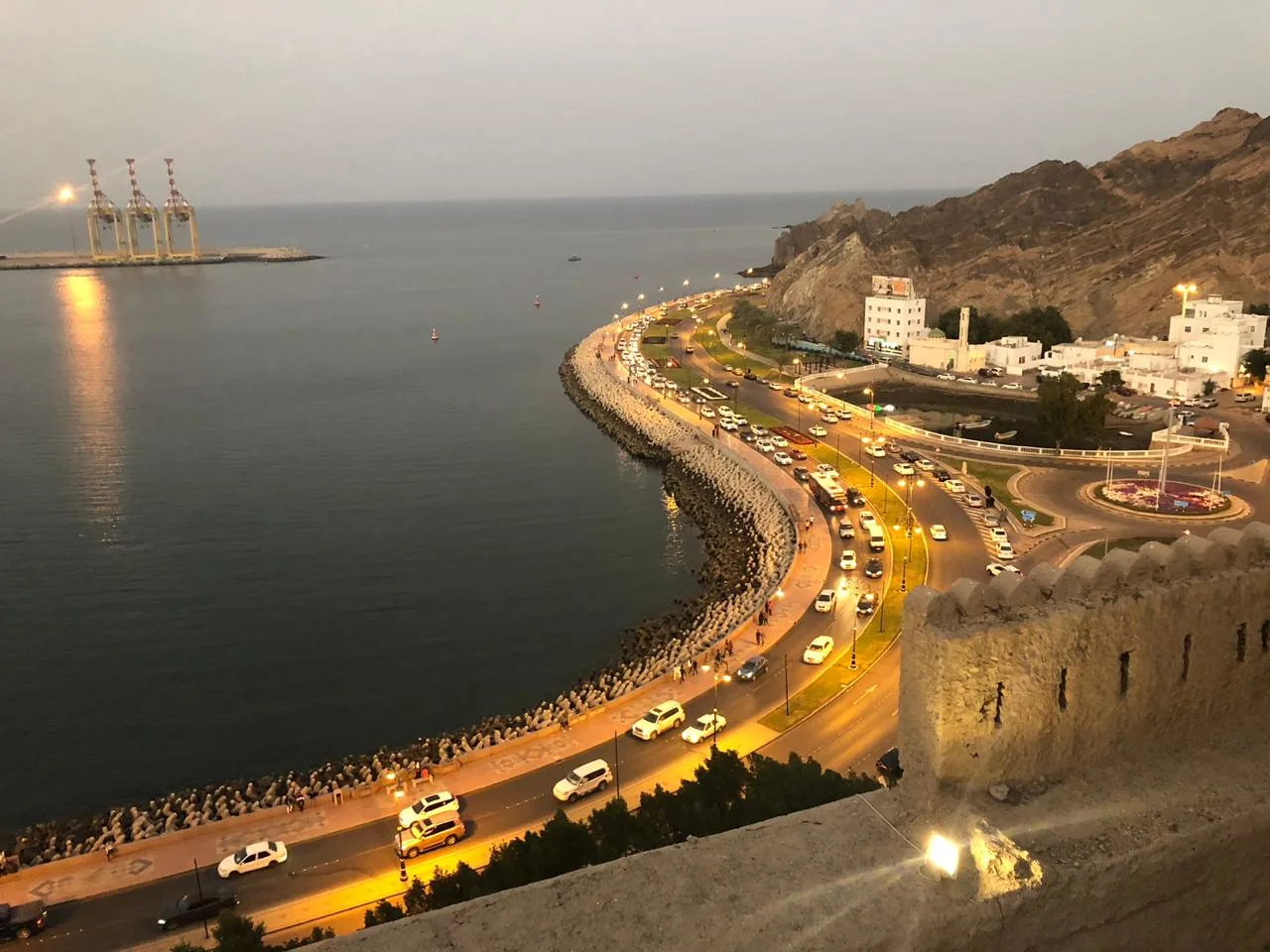
Rahma from The Sane Adventurer: when looking for things to do, Muscat is filled with plenty of adventurous activities to do right in the heart of the city.
One of the most popular activities to do is hiking in Muscat in the tourist hub of Muttrah, which ends with a panoramic view of the Muttrah corniche and the Arabian Sea.
It is a short hike (just 10km) and it can be completely done self-guided. The best time to do the hike is either during the sunrise or the sunset.
The starting point of the hike is right in front of the parking spot of Riyam Park in Muttrah. There is no signage to mark the start of the hike, but one can see stairs carved into the mountain which leads halfway to the top of the mountain.
Along the hike, regular hikers and locals have marked the direction on the rocks, so it is pretty easy to follow the trail and complete the hike.
As it's a relatively short hiking trail, all you need to carry is some water and maybe light snacks if you wish.
However, one important item to pack is water shoes (or wear Teva's or similar sandals), as depending on the weather, there might be quite a few pools of water to cross between the mountains.
The hike ends near the Muttrah fort, which is on a cliff and offers great views of the Corniche road. It is also the best place to see the sunrise or sunset!
Stroll along Muttrah Corniche

Wendy from The Nomadic Vegan: the Muttrah Corniche is a seaside promenade that stretches for three kilometers along the waterfront of Muttrah Bay.
It's the perfect place for a leisurely stroll, particularly at sunset! From the Corniche, you have superb views of the mountains as well as of Muttrah Fort (also mentioned above), which sits on top of a hill protecting the bay.
Built by the Portuguese in the 16th century, it is now open to visitors as a tourist attraction and offers a different view of the bay that includes the corniche itself.
Muttrah is Oman's main port area, so you'll be able to watch the dhows unload their wares at the markets.
You may also spot one of the more prominent boats that are usually moored here, including his Majesty's dhow and a fully-rigged training ship named Shabab Oman.
You'll notice plenty of birdlife here, including huge flocks of seagulls. The water is quite clear, so if you look down you should be able to spot plenty of fish swimming in the bay too.
The Corniche is lined with mosques, restaurants, cafes, and latticed buildings. Most of the buildings are painted white, contrasting sharply against the dark hills.
Restaurants here serve various dishes, including traditional Middle Eastern cuisine and more international flavors. A meal at one of the restaurants with an outdoor terrace would be a perfect way to end your walk along the Corniche.
Muttrah is located in a small cove on the eastern side of Muscat. The main road runs right through it, and it can easily be reached by taxi.
Shop at Muttrah Souq

Muttrah Souq is the traditional old city Souq and the best place to shop for souvenirs in Muscat.
Here you can find pottery, Omani silverware, frankincense, stacks of colorful kummah with intricate patterns (the traditional cap you will see many Omani men wearing in the streets), and much more.
A very typical Omani item is mandoos, beautifully decorated wooden inlay boxes that come in all sizes and are used to store jewelry and clothes.
Another interesting item that can be found in the Muttrah Souq is the khanjar, which is an Omani dagger.
This short curved sword shaped like the letter j has an important ceremonial function at national festivals, weddings, and other social events. So important that you can even find the khanjar on the flag of Oman!
The best time to visit Muttrah Souq (as with most souqs) is in the afternoon or early evening. You will find many Omani women browsing the Souq as well, so it's definitely worth noting which shops they prefer, as this is a good indication of quality wears being sold.
While I often find it quite exhausting to visit a Souq because of the pushy merchants, I really enjoyed visiting Muttrah Souq.
The shop owners are generally very relaxed and friendly, they will help you when you ask for it but they won't drag you inside their shops or try as with some other souqs I've visited.
Perhaps this is due to the fact that Muscat tourism hasn't fully taken off and there is a good balance between locals and tourists visiting the Souq.
In any case, a stroll around Muttrah Souq should be on your ‘Muscat things to do list‘.
Learn about Oman in the National Museum

The National Museum opened in 2016 and is a great place to learn about Oman. It traces the history of Oman through time, starting at the earliest human settlement in Oman.
This vast museum has 14 permanent galleries about various topics, such as maritime history, Oman currency, and an Armoury. You could easily spend half a day or more in this state-of-the-art museum.
There are interactive displays, videos, and welcoming knowledgeable staff that gladly tells you more about the museum and Oman.
The building itself is quite impressive as well, a landmark fit to hold the thousands of artifacts on display here.
Onsite there are a gift shop and a cafe, so you can enjoy a drink before heading to the next Muscat attraction on your itinerary.
Go on an Eco-dolphin watching tour

Nabiha from Verses By A Voyager: Muscat is a city of rugged natural beauty with mesmerizing beaches and an abundance of incredible marine life. In fact, there are perfect dive spots very close to the city!
What's more, did you know that you can see dolphins just off the coast of Muscat, Oman? Just a few kilometers from the Muscat port of Marina Rowdah, beautiful dolphins can be witnessed in pods, an amazing sight to behold!
Not only the sight of dolphins, but the entire boat trip to the sighting spot is very enjoyable and not to be missed on your Muscat itinerary.
There are plenty of boat trips organized from Marina Rowdah, which take you to the spot where dolphins are found in abundance.
Click here to book a dolphin-watching tour
The best reason to go dolphin watching in Muscat is that you can watch dolphins in their natural habitat, rather than in sea-life parks which are unethical to visit.
The best time for this activity is between April and August, as dolphins are most frequently seen during these months. The dolphin-watching Muscat tours last about 3 hours and cost 10 OMR (26 USD).
There are generally two trips every day, one at 8 am and the second one at 12 pm. Note that the 8 am trip is the best one for dolphin spotting.
In order to get to the marina, you can either take a cab (the fastest) or use public transport (the cheapest). Buses run from the city center, the trip is usually quite long but much cheaper than taking a cab.
Dolphin watching in Muscat is definitely a must-do activity when visiting the city during the summer months!
Learn about the history of Muscat at the Bait-Al-Baranda Museum
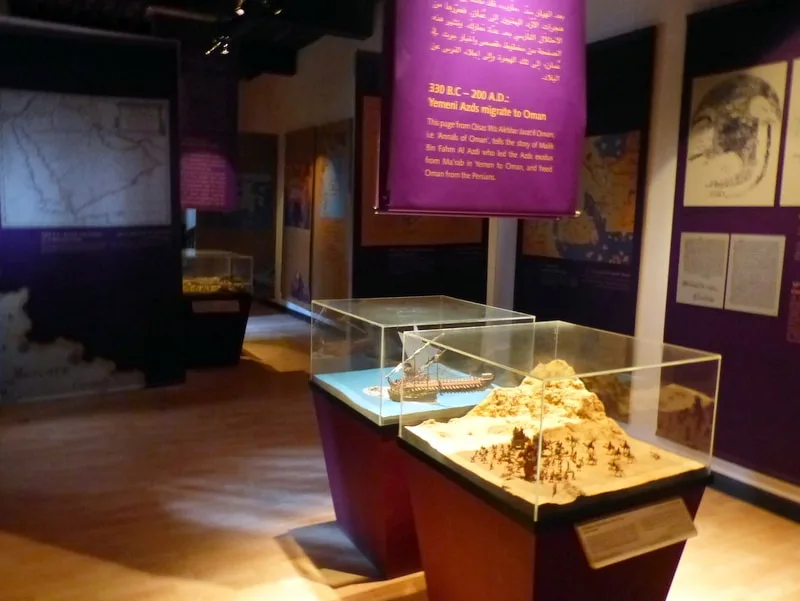
David from Surveys Fanatic: the Bait-Al-Baranda Museum is my favorite museum in Muscat! It's one of the best places in Muscat to learn about the history of the city.
While only a small museum, it still manages to cover the history of Muscat from 750 million years ago until the present day.
The story of Muscat begins with how the area was formed geographically. It's very interesting to learn about the tectonic plates around Muscat and how the surrounding Omani Mountains came to be.
In the Bait-Al-Baranda Museum, you will also learn about the founding of Muscat and how it developed over time. Much of it is shown through maps, which makes it easy to follow the story.
The exhibits are quite interactive, with many questions where you can guess the answer and subsequently read the explanations.
There is also a culture exhibit, with information on folk arts, clothing, and general information about the area. There are lots of informative displays and this museum truly is the best introduction to Muscat and Oman as a whole.
The Bait-Al-Baranda museum currently costs 1 OMR for adults and 500 baisa for kids. It is open Saturday to Thursday, from 9 am to 1 pm and 4 pm to 6 pm.
The museum is located on the seafront in Muttrah, just a short walk from the boardwalk and Muttrah Souq.
Visit the Royal Opera House

Ania from the Travelling Twins: your first impression of Muscat will almost certainly be from the main city artery: the Sultan Qaboos Highway.
The city’s two most majestic buildings both face this road. One of them is the Sultan Qaboos Grand Mosque (mentioned above), and the other one is the Royal Opera House.
The Royal Opera House in Muscat was the first Opera house built in the Middle East. It's not only a beautiful modern building, but it also incorporates advanced technology for translation and engineering for transforming the auditorium.
The main lobby and auditorium are as impressive as the building’s exterior. Lavish interiors of carved and polished white stone and timber combine traditional and modern themes.
They will transport you to a time when a night in an opera was reserved for the rich and noble. If you want to visit the Opera today, dress smart and modestly and enjoy being part of the whole scene.

Important: be mindful of the dress code at the Royal Opera House, even during the day you may not be allowed inside if you are wearing shorts.
If you would like to see the interior, you can book a full tour of the Opera and see for yourself the royal box and all the advanced engineering systems.
Or just drop in during the day between 9 am and 11 am to see the outer hall and box office which will give you a taste of the opulent interiors.
After the performance, you can pop into a number of theater restaurants or cafes in the Galleria, or go for a stroll along Shatti beach, which is only a few hundred meters away.
Relax at Shatti Al Qurum Beach

Elaine from Show them the Globe: Shatti Al Qurum is a lively beach in the heart of Muscat.
With its golden sands and clear waters, Shatti Al Qurum is one of the best beaches in Muscat. The beach is a popular spot for relaxing, swimming, and feeling the sand between one’s toes.
It’s a lovely walk along the coconut tree-covered promenade which lines the beach, where food and drink options include coffee shops, cafes, and BBQ areas.
Shatti Al Qurum is also a great spot to catch the sunset. The views are stunning as the sun slowly sets over the Gulf of Oman.
The beach is a magnet for locals and tourists alike. It gets crowded in the evenings as the Muscat temperatures cool and on Fridays when the weekend starts.
There’s usually lots of activity at Shatti Al Qurum, with groups playing sports such as volleyball and football. It’s also popular with families and was one of our favorite places to spend time in Oman with kids.
Shatti Al Qurum is located in the residential Qurum district which is home to some of Muscat’s finest hotels, the incredible Muscat Opera House (mentioned above), and a theater.
This Muscat beach is most easily reached by car but is also accessible by bus. Make sure to bring sunscreen, water, and lots of patience to grab one of the highly coveted parking spots along the beach!
More Muscat places to visit
Here are some other interesting things to see in Muscat, if you've got some more time to explore this wonderful capital.
Al Alam Palace
One of the official residences of Sultan Qaboos. While the palace is not open to the public, you can explore the gardens around the palace and admire the beautiful building from the outside.
Al Jalali Fort
This impressive fort can be found in the harbor of Old Muscat, Oman.
Originally built by the Portuguese in 1580, it served different functions throughout the decades. The Fort was meticulously restored in 1983 and converted into a museum.
You have to apply for a permit to visit, but even if you don't intend to visit the museum it's still very worthwhile to admire this beautiful Fort (built on top of a rock) from the outside!
Oman Children's Museum

A great place in Muscat for families is the Oman Children's Museum.
Your kids will love this hands-on science museum, with many interactive displays (such as fake electric shocks, triggering a lightning bolt, and photographing your own shadow).
Where to stay in Muscat
Best budget hotels in Muscat
Mutrah Hotel ☆☆
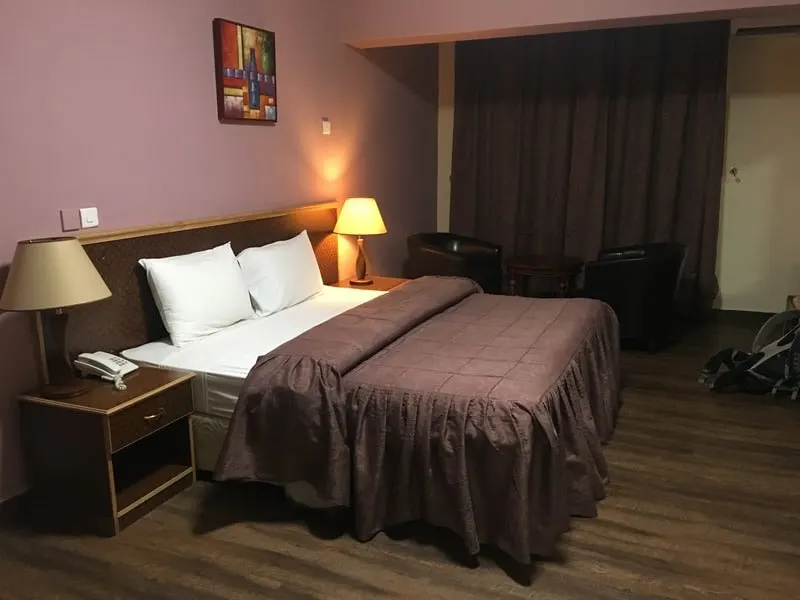
Mutrah Hotel is a great budget hotel in Muscat and within walking distance of Mutrah Souq and the Corniche. The rooms are spacious and clean, the staff is very friendly and the breakfast is very tasty.
Book via Agoda | Book via Booking
The Secure Inn Hotel ☆☆☆

The Secure Inn Hotel is a nice option for those looking for a good but cheap hotel in Muscat. A new and modern hotel with onsite parking, large rooms, and a wellness area (hot tub and sauna).
Book via Agoda | Book via Booking
Best 4-star hotels in Muscat
Levatio Hotel ☆☆☆☆

The Levatio is a beautiful 4-star hotel with an outdoor swimming pool, fitness center, and onsite restaurant.
There is also a spa, free parking, and currency exchange services. Rooms are nicely decorated, and have comfortable beds and tea-making facilities.
Book via Agoda | Book via Booking
Hilton Garden Inn Muscat Al Khuwair ☆☆☆☆

One can never go wrong by staying at a Hilton Hotel. The Hilton Garden Inn Al Khuwair is a modern hotel with a tasteful design and an outdoor pool.
Rooms come with city or mountain views. For traveling families: there is a children's play area as well!
Book via Agoda | Book via Booking
Best luxury hotels in Muscat
Al Bustan Palace ☆☆☆☆☆

This is the most popular and best luxury resort in Muscat. For a bucket-list-worthy stay and to celebrate special occasions such as a honeymoon or wedding anniversary, this is the place to be.
While spending a night at Al Bustan Palace comes with a (hefty) price tag, you will experience Omani hospitality to its fullest.
With an onsite Six Senses Spa, the poolside BLU cocktail bar, and the Ritz Kids entertainment program for children, there is something for every family member to enjoy.
Book via Agoda | Book via Booking
W Muscat ☆☆☆☆☆

Also an excellent 5-star hotel but more affordable is the W Muscat. With professional and attentive staff, beautiful design, an outdoor pool, and not one but five onsite restaurants, you will surely enjoy your stay at the W.
Book via Agoda | Book via Booking
What to see in Muscat: in conclusion
I hope this Muscat guide will help you plan a trip to Muscat, Oman!
It's a beautiful authentic city, where you can eat great Omani food, visit lots of interesting sites and get to know the friendly Omani people. Let me know if you have any questions about planning a trip to Muscat!

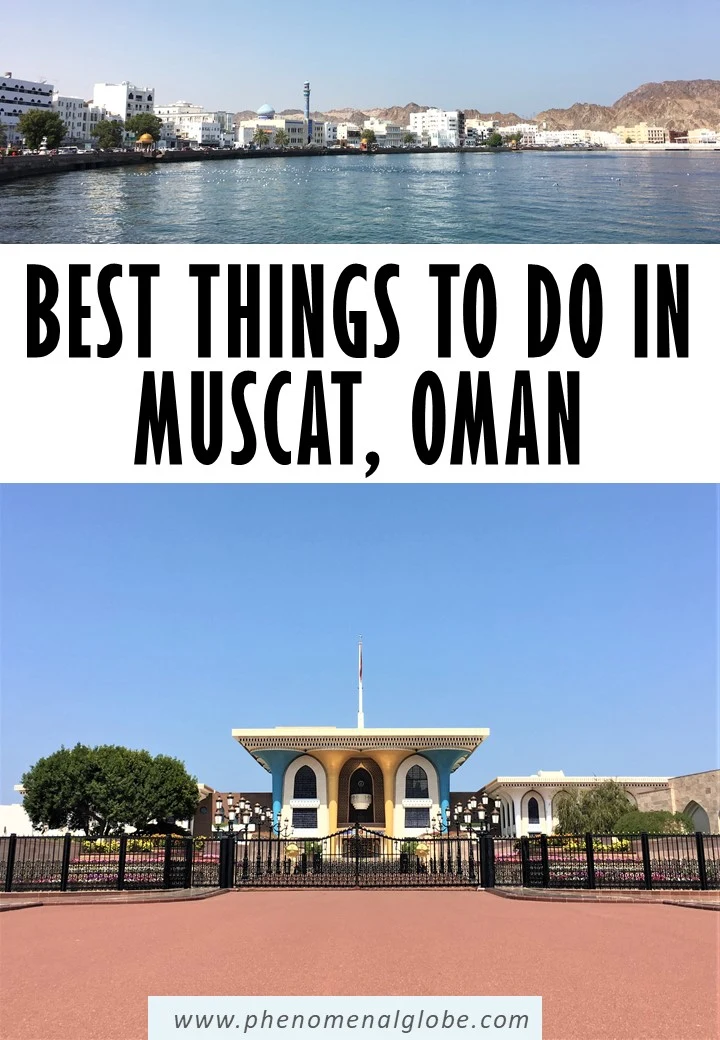
This post was updated in December 2022.



